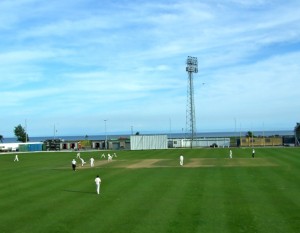While I can’t remember in detail any of the individual strokes, and you can see it all on YouTube anyway, I do recall the sense of incredulity when we realised we had just seen a piece of cricketing perfection, a feat never accomplished before in the entire history of the game. The reaction was strangely muted, as if people were in a trance.
We did not jump to our feet, hollering and whooping and hugging one another, as people might do today. There was only a partial standing ovation, which shows how that particular gesture has been devalued, through overuse, over the years.
It was the greatest piece of piece of batting I’d ever seen, and Garfield Sobers was a cricketing genius.
I’m talking, of course, of that distant day in Swansea in 1968, when the West Indian cricketer became the first player in the history of the sport to hit every ball of an over for six, playing for Nottinghamshire against Glamorgan. I was so lucky and privileged to be there.
It was the 31st of August, at the St Helen’s cricket ground. Nottinghamshire, with Sobers as the captain, were playing Glamorgan. Sobers was reportedly angry because his middle order batsmen had been lethargic, more keen on protecting their wickets and their averages than making runs.
He wanted to speed up the run rate so he could declare, and set his bowlers on the home team. He surveyed the field, sized up the bowler Malcolm Nash, and the rest is history.
I was born in Swansea, and I had gone to the ground that day with my father. My e-book “Sobers Six Hit Perfection at Swansea: That was the Day, is an account of the events of that famous afternoon.
I also try to put that epic piece of hitting in its context, as one of the remarkable events in a remarkable year, 1968, and as one of the great sporting occasions.
1968 was a year of political assassinations, near-revolution in Paris, a brutal suppression of the people of Czechoslovakia by the USSR, student protests, massive demonstrations against the Vietnam War and the first journey by man around the moon.
It was a big year for sport too. Shortly after Sobers’ feat, US athlete Bob Beamon beat the world long jump record by almost two feet. And the England cricket tour to S Africa was called off after the hosts said “coloured” cricketer Basil D’Oliveira was not welcome in the team. That was one of the events that led to the end of apartheid.
It seemed to make sense that in those tempestuous times, with so many remarkable, frantic, tragic, heroic things happening, that the finest cricketer of the era should break a record. It was part of the iconoclasm.
Sobers Six Hit Perfection at Swansea: That was the Day is available from Amazon to be read on the Kindle, iPad and other mobile devices, price 77p. http://amzn.to/JSWCxG

